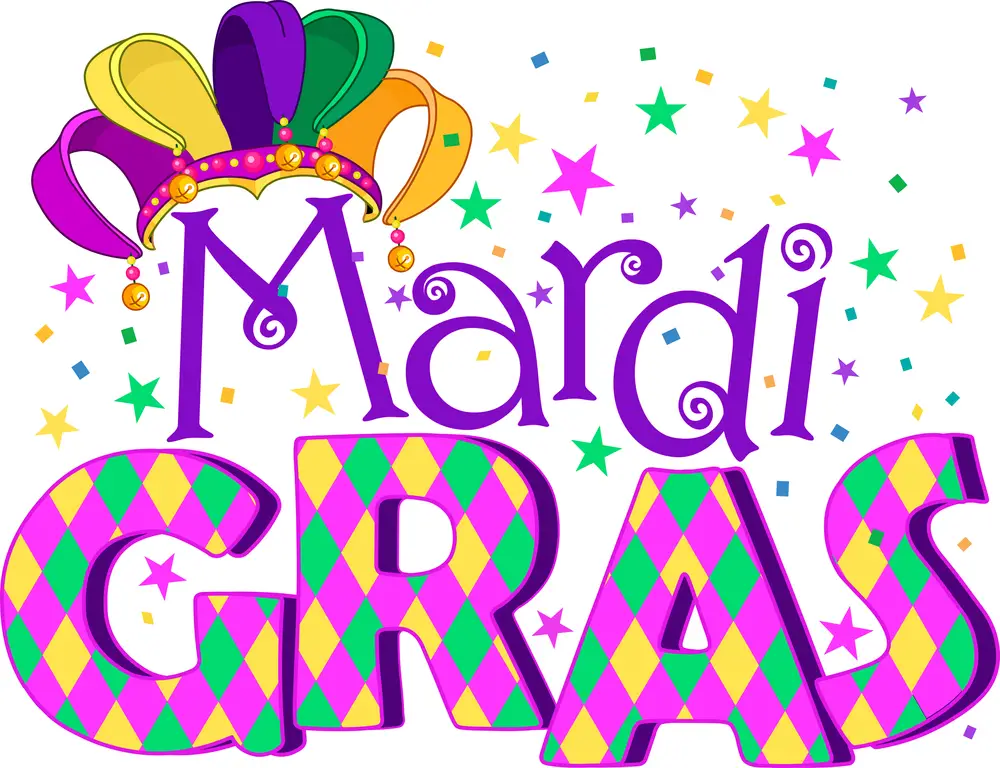Mardi Gras is a time for celebration, parades, and colorful decorations. But, when should you put up and take down Mardi Gras decorations? While there’s no official date, it’s generally accepted to display them from Twelfth Night until Fat Tuesday.
In this article, we’ll explore some tips for storing your decorations and keeping them in good condition for next year.
Key Takeaways
- Mardi Gras season begins on January 6th and ends on Fat Tuesday, which falls on the day before Ash Wednesday.
- There’s no hard and fast rule for when to put up your Mardi Gras decorations, but many people choose to do so in the weeks leading up to Mardi Gras.
- When to take down your Mardi Gras decorations is a matter of personal preference, with some people taking them down immediately after Mardi Gras and others leaving them up for a few days or even weeks.
History and Significance of Mardi Gras
Origin and Evolution
Mardi Gras, also known as Carnival, is a festival celebrated around the world. Its origins can be traced back to ancient Roman celebrations of fertility and the coming spring season. When Christianity spread through Europe, the festival evolved into a period of feasting and celebration before the start of Lent, a period of fasting and repentance.
Mardi Gras arrived in the United States in the late 17th century when French explorers Pierre Le Moyne d’Iberville and Sieur de Bienville landed near present-day New Orleans, Louisiana, and held a small celebration. Over time, the festival grew in popularity and became an important part of Louisiana’s culture.
In 1870, the first Mardi Gras parade was held in New Orleans by a group called the Mistick Krewe of Comus. Since then, Mardi Gras has become a major event in New Orleans, with elaborate parades, extravagant costumes, and lively street parties.
Significance of Mardi Gras in New Orleans
Mardi Gras is an important cultural event in New Orleans, with a rich history and many traditions. The festival is celebrated for several weeks leading up to Fat Tuesday, the day before Ash Wednesday, which marks the beginning of Lent.
One of the most important Mardi Gras traditions in New Orleans is the creation of krewes, which are organizations that plan and participate in the parades and other festivities. Each krewe has a unique theme and design for their parade floats and costumes, and many krewes have been around for generations.
Another important tradition is the throwing of beads, trinkets, and other items from the parade floats to the crowds below. This tradition dates back to the early 20th century and has become an iconic part of Mardi Gras in New Orleans.
Overall, Mardi Gras is a celebration of life, community, and tradition. It brings people together from all walks of life to celebrate and enjoy the festivities.
Mardi Gras Decorations and Their Meanings

Mardi Gras decorations are an essential part of the festive season. They add color, excitement, and an air of celebration to homes, businesses, and streets. Understanding the meanings behind these decorations can add to the enjoyment of the season. Here are some common Mardi Gras decorations and their meanings:
Colors
The traditional Mardi Gras colors are purple, green, and gold. These colors represent justice, faith, and power, respectively. Purple is also associated with royalty, while green represents nature and growth. Gold is associated with wealth and prosperity.
Beads
Mardi Gras beads are an iconic symbol of the season. They are often thrown from parade floats and caught by revelers. The tradition of throwing beads dates back to the late 19th century. Today, beads come in a variety of colors and shapes, and many have unique designs or messages.
Costumes and Masks
Mardi Gras costumes and masks are a fun way to get into the spirit of the season. They can be as simple or elaborate as you like. Masks are particularly popular and are often decorated with feathers, sequins, and other embellishments. They can be used to conceal one’s identity and add an air of mystery to the festivities.
King Cake
King Cake is a traditional Mardi Gras dessert. It is a sweet, ring-shaped cake that is decorated with purple, green, and gold icing. Inside the cake, there is a small plastic baby. The person who finds the baby in their slice of cake is said to have good luck for the coming year.
Throws
Throws are items that are thrown from parade floats to spectators. They can include beads, cups, stuffed animals, and other small items. Many throws are decorated with the traditional Mardi Gras colors and symbols.
Decorations
Mardi Gras decorations can include ornaments, garland, banners, signs, and more. They are often decorated with the traditional colors and symbols of the season. Fleur de lis, a stylized lily, is a popular symbol used in Mardi Gras decorations. Gold ornaments and Mardi Gras centerpieces are also common.
Understanding the meanings behind Mardi Gras decorations can add to the enjoyment of the season. Whether you choose to decorate your home or join in the festivities, these symbols and traditions are an important part of Mardi Gras celebrations.
Decorating Your Home for Mardi Gras
When it comes to decorating your home for Mardi Gras, the possibilities are endless. From colorful beads to festive garlands, there are many ways to add some carnival spirit to your living space.
Here are some tips to help you get started:
Mardi Gras Decorations
Mardi Gras decorations come in all shapes and sizes. You can find everything from traditional masks and beads to more unique décor like Mardi Gras-themed signs and centerpieces. When choosing your decorations, consider the color scheme you want to use. Purple, green, and gold are the traditional Mardi Gras colors, so incorporating these hues into your decor can help tie everything together.
Lights
Adding some festive lights to your Mardi Gras decor can help create a fun and lively atmosphere. Consider using string lights in purple, green, and gold, or opt for some colorful LED lights to add some extra sparkle.
Garlands and Bows
Garlands and bows are a great way to add some dimension to your Mardi Gras decor. You can find garlands in a variety of colors and styles, from traditional tinsel to more unique options like feather boas. Adding some bows to your garlands or wreaths can also help tie everything together.
Door Decor
Don’t forget about your front door! Adding some Mardi Gras-themed decor to your door can help set the tone for your entire home. You can find Mardi Gras wreaths, door hangers, and signs to add some festive flair.
When to Put Up Mardi Gras Decorations
The official start of the Mardi Gras season is on Jan. 6, also known as Twelfth Night or King’s Day. This is the traditional day to put up your Mardi Gras decorations.
However, some people like to put up their decorations a few weeks before Mardi Gras, while others wait until the week of the holiday. Either way is fine, as long as you make sure your decorations are up in time for the big day!
The weather can also play a role in when to put up your Mardi Gras decorations. If you live in a colder climate, it may be best to wait until closer to the holiday to avoid damage from snow and ice. On the other hand, if you live in a warmer climate, you can put up your decorations earlier without worrying about weather damage.
If you’re planning to celebrate Mardi Gras in the French Quarter of New Orleans, it’s important to note that the city has specific regulations for when you can put up your decorations. According to the city’s official website, decorations can be put up no earlier than four weeks before Mardi Gras day.
| Entity | Relevant Information |
|---|---|
| Carnival Season | The official start of the Mardi Gras season is on Jan. 6, also known as Twelfth Night or King’s Day. |
| Epiphany | Jan. 6 is also known as Twelfth Night or King’s Day. |
| Official | New Orleans has specific regulations for when you can put up your decorations. |
| Weather | Consider the weather when deciding on the best time to put up your Mardi Gras decorations. |
| French Quarter | If you’re celebrating Mardi Gras in the French Quarter of New Orleans, decorations can be put up no earlier than four weeks before Mardi Gras day. |
| Jan. 6 | Jan. 6 is the traditional day to put up your Mardi Gras decorations. |
| Twelfth Night | Jan. 6 is also known as Twelfth Night or King’s Day. |
| King’s Day | Jan. 6 is also known as Twelfth Night or King’s Day. |
| Mardi Gras Day | Make sure your decorations are up in time for the big day! |
When to Take Down Mardi Gras Decorations
Once the Mardi Gras festivities come to an end, it’s time to take down your decorations. While there is no hard and fast rule, there are a few guidelines you can follow to make sure you take down your decorations at the right time.
Firstly, it’s important to remember that Mardi Gras always falls on the Tuesday before Ash Wednesday, which marks the beginning of Lent. This means that the date of Mardi Gras changes every year, but it typically falls between February 3rd and March 9th.
With that in mind, it’s generally recommended that you take down your Mardi Gras decorations by Ash Wednesday.
This is because Ash Wednesday marks the beginning of the Lenten season, which is a time of reflection and sacrifice for many Christians. Taking down your Mardi Gras decorations by this time shows respect for the religious significance of the season.
If you’re not able to take down your decorations by Ash Wednesday, the next important date to keep in mind is Easter Sunday. Easter Sunday falls on the first Sunday after the first full moon following the vernal equinox. This means that Easter Sunday can fall anywhere between March 22nd and April 25th.
If you haven’t taken down your Mardi Gras decorations by Easter Sunday, it’s definitely time to do so. This is because Easter Sunday marks the end of the Lenten season, and it’s a time of celebration for many Christians.
Taking down your Mardi Gras decorations by this time shows that you’re ready to move on from the Mardi Gras festivities and embrace the new season.
Conclusion
Overall, Mardi Gras is a fun and festive holiday that is celebrated in many different ways. Whether you are in New Orleans or not, you can still join in the fun by putting up your own Mardi Gras decorations. Just remember to take them down within a week after the holiday is over.

